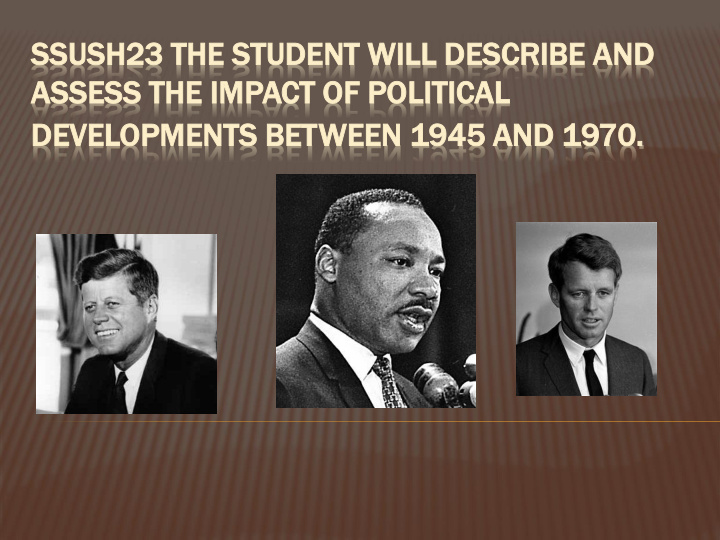



SSUSH SUSH23 23 THE E STUDENT UDENT WIL ILL L DES ESCRIBE CRIBE AND ASSESS SESS THE E IM IMPACT CT OF POLI LITIC TICAL AL DEV EVEL ELOPMENT PMENTS S BET ETWEEN EEN 194 945 5 AND 1970. 70.
A. DESCRIBE THE WARREN COURT AND THE EXPANSION OF INDIVIDUAL RIGHTS AS SEEN IN THE MIRANDA DECISION. Earl Warren was appointed Chief Justice of the United States Supreme Court in 1953 Warren led the Supreme Court in making several decisions on key political and social issues The Warren Court made decisions in such famous cases as Brown v. Board of Education Mapp v. Ohio, Gideon v. Wainwright, and Miranda v. Arizona American Liberals generally applaud Warren as an upholder of civil liberties. Nevertheless, many Conservatives feel that he led the Court to overstep the boundaries of its constitutional role.
SCOTUS: THE WARREN COURT 1. 1. 1950S, 1960S: SCOTUS TUS CHIEF IEF JUSTIC TICE, E, EARL RL WARRE REN, N, AKA, WARRE REN N COURT 2. LANDMARK DECISIONS 3. EXAMPLES 1)BROWN WN V. BOARD RD OF EDUCA DUCATION TION, , 1954, SCOTUS TUS 2)MIRA IRAND NDA A V. ARIZON ZONA, , 1963, POLICE MUST INFORM SUSPECTS OF CONSTITUTIONAL RIGHTS AT THE TIME OF ARREST… (THIS DECISION STRENGTHENED AMERICANS’ INDIVIDUAL RIGHTS.) GHTS.) 3)RIGHT OF FREE SPEECH PROTECTS STUDENTS WHO WEAR ARMBANDS AS ANTI-WAR PROTEST ON SCHOOL GROUNDS
BROWN V. BOARD OF EDUCATION Brown v. Board of Education of Topeka, 347 U.S. 483, was a landmark United States Supreme Court case in which the Court declared state laws establishing separate public schools for black and white students to be unconstitutional. Strikes down Separate But Equal Clause established by Plessy v. Ferguson (1896).
BROWN V. BOARD OF EDUCATION
CHIEF JUSTICE EARL WARREN Earl Warren (March 19, 1891 – July 9, 1974) was the 14th Chief Justice of the United States and the only person ever elected three times as Governor of California. The Warren Court became recognized as a high point in the use of the judicial power in the effort to effect social progress in the U.S.; Warren himself became widely regarded as one of the most influential Supreme Court justices in the history of the United States and perhaps the single most important jurist of the 20th century. Warren was the last Chief Justice born in the 19 th Century.
THE WARREN COURT Er Ernest esto o Ar Artur uro Miranda nda ( March 9, ERNESTO MIRANDA 1941 – January 31, 1976) was a laborer whose conviction on kidnapping, rape, and armed robbery charges based on his confusion under police interrogation resulted in the landmark US Supreme Court case ( Miranda v. Arizona ), which ruled that criminal suspects must be informed of their right against self-incrimination and their right to consult with an attorney prior to questioning by police. This warning is known as a Miranda warning.
MIRANDA DECISION In the Miranda decision of 1966, the Supreme Court ruled that suspects must immediately be notified of their rights: -Right to remain silent - Right to a lawyer, even if they couldn’t afford one Though criticized by many Americans, Miranda expanded the rights of the accused by guaranteeing equal rights to all citizen regardless of their economic situation
B. DESCRIBE THE POLITICAL IMPACT OF THE ASSASSINATION OF PRESIDENT JOHN F. KENNEDY; INCLUDE THE IMPACT ON CIVIL RIGHTS LEGISLATION. Kennedy, especially towards the end of his Presidency, was viewed as being very progressive towards the civil rights movement In November 1963, Kennedy was assassinated in Dallas, TX Vice-President Lyndon Johnson, from Texas was sworn in as President Politically, Johnson was very different than Kennedy: - Spent years in Congress, and knew how to get things done
JOHNSON ADMINISTRATION Johnson carried on many of Kennedy's plans including getting both the Civil Rights Act of 1964 and the Voting Rights Act of 1965 passed into law
C. EXPLAIN LYNDON JOHNSON’S GREAT SOCIETY; INCLUDE THE ESTABLISHMENT OF MEDICARE Johnson ran and won the 1964 Presidential election Johnson immediately set in motion his “Great Society” plan His plan was based on Franklin Roosevelt’s New Deal, and focused on expanding aid to the poor through a variety of programs
MEDICARE During a three year period, the Johnson administration passed over 60 programs as part of the Great Society Medicare, which was established in 1965, provided health care for the elderly Though some of the Great Society programs turned out to be great successes, Johnson’s plan was eventually undermined by the increased financial burden of the Vietnam War
D. DESCRIBE THE SOCIAL AND POLITICAL TURMOIL OF 1968; INCLUDE THE ASSASSINATIONS OF MARTIN LUTHER KING, JR. AND ROBERT F. KENNEDY, AND THE EVENTS SURROUNDING THE DEMOCRATIC NATIONAL CONVENTION. In late March, Martin Luther King Jr. went to Memphis, TN to help support a strike by African American sanitation workers In the early evening of April 4, Dr. King was shot and killed by James Earl Ray King’s death sparked a series of riots across the country
ROBERT F. KENNEDY Robert Kennedy was John Kennedy's brother and served as the U.S. Attorney General under his administration Robert Kennedy, supporting many of his brother’s civil rights policies, decided to run for president in 1968 As a Democratic candidate, Kennedy went to California in June of 1968 and won that state’s primary.
ROBERT F. KENNEDY After greeting supporters at a hotel after his victory, Robert Kennedy was assassinated by Sirhan Sirhan By the end of 1968, two national leaders had been assassinated
1968 DEMOCRATIC NATIONAL CONVENTION The 1968 Democratic National Convention was held in Chicago, IL. 4,000 anti-war demonstrators (Vietnam War), tried to march to the convention site but were met by over 11,000 army and National Guardsmen, and Chicago riot police
1968 DEMOCRATIC NATIONAL CONVENTION Protesters and bystanders were met with tear-gas, and beaten by the police, all within the full view of television cameras
Recommend
More recommend